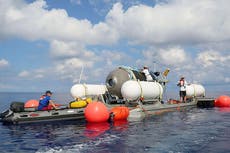‘Where there is life there is death’: Why ‘dark tourists’ pay to put their lives at risk
It may seem strange to many of us, but a morbid curiosity draws tourists to the strangest – and most forboding – corners of the world, writes Dr Donna Poade

Your support helps us to tell the story
From reproductive rights to climate change to Big Tech, The Independent is on the ground when the story is developing. Whether it's investigating the financials of Elon Musk's pro-Trump PAC or producing our latest documentary, 'The A Word', which shines a light on the American women fighting for reproductive rights, we know how important it is to parse out the facts from the messaging.
At such a critical moment in US history, we need reporters on the ground. Your donation allows us to keep sending journalists to speak to both sides of the story.
The Independent is trusted by Americans across the entire political spectrum. And unlike many other quality news outlets, we choose not to lock Americans out of our reporting and analysis with paywalls. We believe quality journalism should be available to everyone, paid for by those who can afford it.
Your support makes all the difference.There aren’t many people who would willingly cram into a tiny vessel and plunge to deadly depths. But for some, there is something endlessly alluring about the ghostly vessel of the Titanic, interred at the bottom of the Atlantic.
That’s why the news of the missing Titan submersible has captured the attention – and the imagination – of the world. As a scholar in the growing field of “dark tourism” research, activities like the ill-fated OceanGate expedition and other sightseeing endeavours associated with suffering and tragedy come as no surprise to me.
The phenomenon of “dark tourism” has fascinated researchers for many years, but tourists are being increasingly drawn to places associated with atrocity, violence and disaster. Historic sites include Auschwitz-Birkenau, Chernobyl (before the war in Ukraine) and Ground Zero. However, “experiences” can now be excursions to sites of slavery, war, the famous dead, serial murder, natural disasters and, as in the case of the OceanGate trip, maritime tragedies such as the Titanic.
Strictly speaking, this isn’t a new phenomenon. Travel to such sites and attractions has existed in many different forms throughout history; think of the gladiatorial games, medieval pilgrimages, guided morgue tours in the 19th century and the spectacle of public executions. Indeed, the display of notorious murderer William Smith’s executed body on Finchley Common near London attracted 40,000 people on the Sunday after his execution in 1782. But it is very much on the rise — as people with money to burn seek out extraordinary experiences.
What is the allure? Where there is life there is death. This is an uncomfortable truth which will affect us all. Humankind throughout history has been preoccupied with death, manifest in rituals, rites and customs and interpreted in an eclectic array of artistic symbolism such as the famous depiction of the ‘Dance of Death’ by the German artist Michael Wolgemut in 1493.
Research highlights a preoccupation with death manifest in culture and art depicted in songs, rituals, customs, and events – such as the Day of the Dead celebrated worldwide or “Obon” in Japan. There may be elements of voyeurism in dark tourism and escapism and fantasy for tourism more generally. Other motivations may include acts of collective grievance or to commemorate and memorialise tragic events.
Those are the whys. Many people might feel queasy at the idea of sites of human atrocity becoming commercialised and snapped for Instagram, but dark tourism is not always negative. More recent research suggests that many visitors are now motivated by a desire and an interest in cultural heritage, learning, education, and understanding about the site itself.
In the case of the missing Titan submarine, it is unclear what the individual and collective motivations are. However, what is interesting is that access to extreme quests is easier with huge wealth and that people will always engage in “risky” behaviours to seek out truths and attempt to solve mysteries, especially those shrouded in death and tragedy.
These days, there’s a vast array of experiences on offer to suit every desire and requirement of the potential traveller. Consequently, dark tourism is a phenomenon that will continue to grow given the supply of experiences on offer coupled with an increasing desire for unique, immersive, and affective experiences.
There are some challenges for industry, however. Academic research explores some thorny issues highlighting the ethical and moral considerations of these activities. Key questions include whether it is morally acceptable to commodify the dead and how we balance education and access with the risk of exploitation or voyeurism.
There is still hope that the passengers onboard the OceanGate vessel will be found. However, academics and the media will continue to ask important questions; exploring why tourists are drawn to the dark, understandings the ethics of this trend and helping to ensure that future travellers and explorers understand the risks.
Dr Donna Poade is Senior Lecturer in Experience Design (Tourism) at Falmouth University



Join our commenting forum
Join thought-provoking conversations, follow other Independent readers and see their replies
0Comments